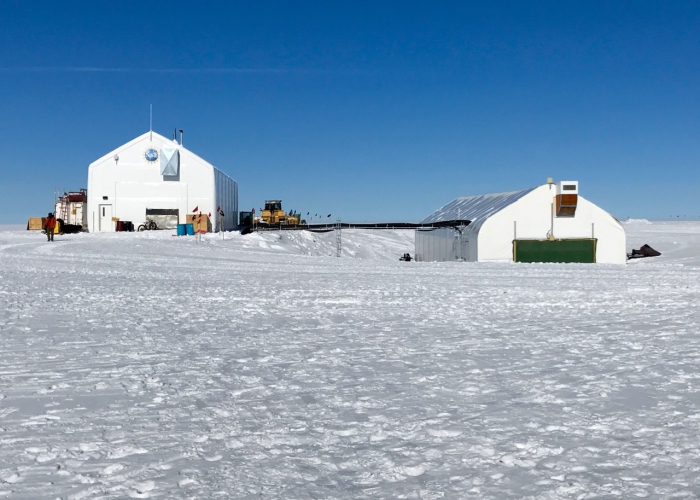NSF Arctic Sciences Town Hall to Convene During 2017 AGU Fall Meetings
Program Directors from NSF's Office of Polar Programs Arctic Sciences Programs will provide an overview of recent and upcoming news of interest to the research community at a town hall meeting during the 2017 AGU Fall Meetings. Topics will include staffing changes in the Arctic Section, proposal pressure in 2017 versus 2016 without proposal deadlines, and upcoming opportunities at NSF of interest to Arctic researchers (including mid-scale research infrastructure, partnerships in geosciences-cyberinfrastructure, Navigating the New Arctic, and Prediction of and Resilience against Extreme Events (PREEVENTS). Program Directors anticipate giving a brief presentation with the bulk of the time devoted to questions and discussion.
This town hall will convene 5:15 – 6:15 p.m. on Tuesday, 12 December 2017 in the ARCUS Arctic Community Meeting Room, located in Riverside Room 1 on the second floor of the Hampton Inn & Suites New Orleans-Convention Center in New Orleans, Louisiana.
For more information, contact Cynthia Suchman (csuchman [at] nsf.gov), Program Director, Arctic Natural Sciences, Office of Polar Programs, NSF
NSF's Research Support and Logistics: Summit Station
Summit Station is a U.S. Arctic science research hub at the apex of the Greenland Ice Sheet. CH2M Hill Polar Services operates Summit on behalf of the National Science Foundation (NSF). Summit has hosted a diverse array of science operations since its inception as the base camp for the drilling of the Greenland Ice Sheet Project 2 ice core in 1989. Summit is the only high- altitude, inland, year-round observing station in the Arctic, offering unique access to the free troposphere, stable atmosphere, and a clean air and snow sector.
To focus upcoming investments in the station infrastructure, and to provide a guide to the future of Summit as a resilient and state-of-the-art scientific platform, the Arctic Research Support and Logistics program in NSF's Office of Polar Programs has created a vision for future operations at Summit. This vision statement evolved as a result of dialogue between NSF and the scientists and support personnel who work and live at Summit, and it will guide decision making in the years to come.

NSF Vision for Research Support and Logistics at Summit Station
Summit Station will become an efficient, flexible observing platform supporting seasonal campaigns for research and training as well as a variety of research fields utilizing state-of-the-art technology to enable year-round measurements made autonomously or with minimal human presence.
Summit Station will remain an important polar research station contributing to an Arctic network of observations and supporting cutting-edge research in a variety of disciplines by international teams, as well as providing a training platform for next generation research scientists. Observations at Summit Station contribute to a broad scientific understanding of the atmosphere and cryosphere including: tracking atmospheric pollution and Arctic-wide transport, snow chemistry, air-snow interactions, weather prediction, understanding changes in the Arctic climate system, the surface mass balance of the Greenland Ice Sheet, and the physics of snow and ice. Research involving observations of the atmosphere, cryosphere, space weather, particle physics, seismology of the ice sheet, and astronomy and astrophysics is potentially transformative and improves our understanding of the Earth, the influence of the Sun on Earth's atmosphere, and the origins of the Universe. Building on more than thirty years as a research site, Summit Station is anticipated to continue to serve as a platform for these studies and as a test bed for new sensors and technology designed for remote operation or autonomous exploration in isolated regions and harsh environments. Continued improvements in communications technology will soon allow for scientists and the public to fully participate in experiments and events at Summit Station from anywhere.
Summit Station will be maintained, augmented, and upgraded as a research support and infrastructure hub subject to available funds and successfully competed NSF science projects as well as research funded by other U.S. and International organizations, as appropriate. The vision includes the following objectives:
- Preserve Summit Station's clean air and snow sectors for science investigating processes in the coupled atmosphere-cryosphere-climate systems, while also providing and allocating space for science not reliant on pristine air and snow.
- Continue to serve as a platform for training next generation scientists.
To achieve this vision, we will:
- Develop a flexible site with facilities that meet changing requirements through designs aimed towards efficiency and safety that allow for easy reconfiguration of space and autonomous operation of heat, energy, and other requirements, including the capability to safely and easily winterize all infrastructure for unmanned periods and subsequently reactivate it.
- Provide scalability to allow for future project additions or reductions, depending on the demands of the NSF science community.
- Implement systems that allow for autonomous data collection.
- Develop the capability to support funded research during unmanned periods.
For more information, visit the Summit Station website or contact Jennifer L. Mercer (jmercer [at] nsf.gov), NSF Program Manager, Arctic Research Support and Logistics (RSL).
